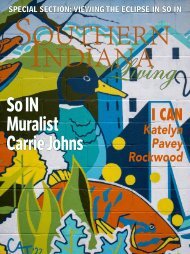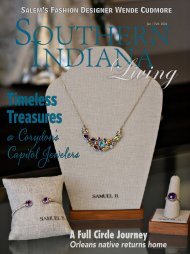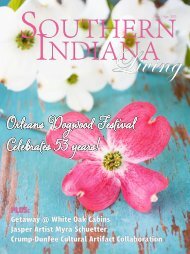Southern Indiana Living Magazine - Jan / Feb 2023
January / February 2023 issue of SIL
January / February 2023 issue of SIL
- No tags were found...
You also want an ePaper? Increase the reach of your titles
YUMPU automatically turns print PDFs into web optimized ePapers that Google loves.
Artist Spotlight<br />
A Quiet Intensity<br />
Corydon Artist Wendi Smith champions the natural world<br />
Story by Judy Cato<br />
Photos by Lorraine Hughes<br />
Less than a block from the historic<br />
Cedar Hill Cemetery in<br />
Corydon, the studio and home<br />
of mixed media artist Wendi<br />
Smith blends into the bordering hillside<br />
and treetop canopy like some<br />
dreamy treehouse. Smith, at 70, navigates<br />
the hill with ease, walking daily<br />
farther up the hill to the cemetery.<br />
“It is a fascinating place,” Smith<br />
said of Cedar Hill. “The old gravestones<br />
are full of history and symbolic<br />
art. I also find actual objects there<br />
– feathers, insect wings, snakeskins,<br />
animal bones, twigs – which become<br />
part of my art.”<br />
Smith’s recent solo show, Elegy,<br />
at Garner Narrative Art Gallery in<br />
Louisville (Sept. 3–Oct. 10, 2021) was<br />
inspired, at least in part, by her walks<br />
at Cedar Hill. As the show’s title suggests,<br />
it was intended as a poem or<br />
song for the dead: the artworks were<br />
tombs of insects, birds and various<br />
other nonhuman species.<br />
One of the works for this show,<br />
Wishbone Reliquary, is a box with an<br />
inside chamber where relics of the<br />
dead – a wishbone, a squirrel tail,<br />
butterfly wings and more – are arranged,<br />
each in their own separate<br />
compartment. On the outside of the<br />
box, Smith has painted precise replicas<br />
of the contents.<br />
22 • <strong>Jan</strong>/<strong>Feb</strong> <strong>2023</strong> • <strong>Southern</strong> <strong>Indiana</strong> <strong>Living</strong><br />
“When I was in art school in<br />
the early ’70s, photorealism was in<br />
vogue,” Smith said. “I was instructed<br />
to make a painting with photographic<br />
accuracy and no hint of self-expression.<br />
This did not always suit me.”<br />
At one level, this work is a pun:<br />
The viewer can compare the original<br />
objects to Smith’s paintings of them.<br />
“Viewers can see how ‘correctly’ I<br />
paint. My skill is out of the box,”<br />
Smith quipped.<br />
The deeper meaning of the<br />
work is a very personal expression of<br />
Smith’s quiet, but intense, reverence<br />
for the natural world. She explained<br />
her intention: “Nature provides so<br />
much of the beauty and wonder of<br />
our existence that we abuse and ignore<br />
it at our peril. The death of an<br />
insect or bird, as children instinctively<br />
feel, can be a loss so huge that<br />
they will give it a burial ceremony to<br />
grieve the loss of so much joy. These<br />
works are an attempt to make sacred<br />
the tombs of turtles and birds.”<br />
Technically, the boxes in the Elegy<br />
exhibit are low color and reduced<br />
pattern to lend solemnity to the contents.<br />
Smith used metal leaf – a thin<br />
foil used for gilding – as a nod to historic<br />
reliquaries and to give them a<br />
formal feel.<br />
In her most recent works – portable<br />
shrines for endangered or threatened<br />
wildlife – the outsides of the<br />
boxes are left unfinished and must be<br />
opened to reveal the contents: painted<br />
images of monarchs, bumblebees,<br />
whooping cranes, Indochinese tigers<br />
and more.<br />
“Opening these shrines brings<br />
the expectation of something valuable,”<br />
Smith said. “We keep our treasures<br />
in boxes and vaults. Natural<br />
treasures are often seen as less valuable<br />
– something our eyes pass over<br />
without thought – because they are<br />
so accessible. Placing them in closed<br />
shrines changes the perception.”<br />
The title of one of these shrines,<br />
Missal, suggests the work might be<br />
approached as if it were a book of<br />
devotions. The viewer opens the unadorned<br />
wood box to find Smith’s<br />
painting of one of nature’s most glorious<br />
works of art: monarch wings,<br />
with their natural geometric shapes,<br />
vivid orange colors, intricate veins,<br />
spotted borders, all designed as a<br />
beacon for a mate, a camouflage and<br />
a warning to predators. The work<br />
seems to invite the viewer to contemplate<br />
this fragile and threatened<br />
beauty as a revelation.<br />
Ceremonial and ritual objects,<br />
such as shrines, missals and reliquaries,<br />
have been important components
















